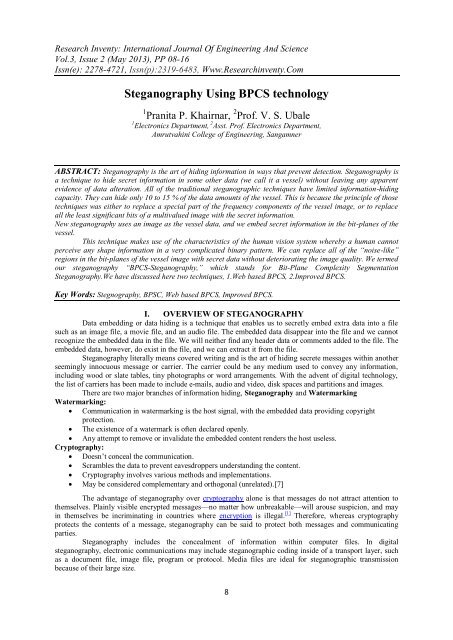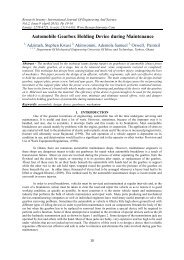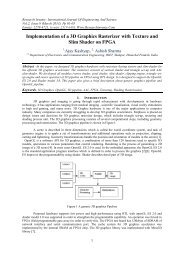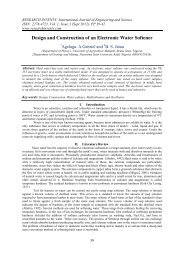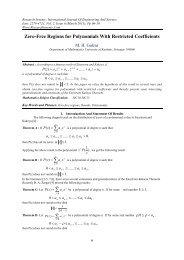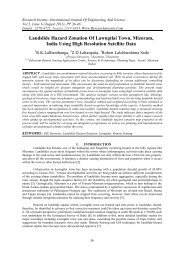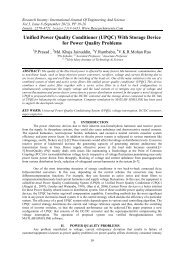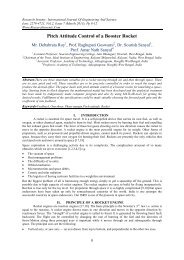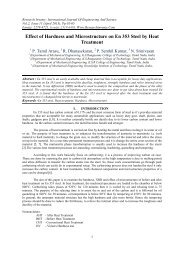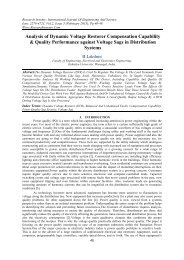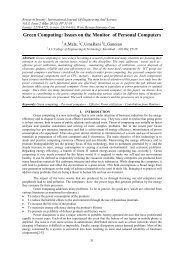Steganography Using BPCS technology - Research Inventy
Steganography Using BPCS technology - Research Inventy
Steganography Using BPCS technology - Research Inventy
- No tags were found...
Create successful ePaper yourself
Turn your PDF publications into a flip-book with our unique Google optimized e-Paper software.
<strong>Research</strong> <strong>Inventy</strong>: International Journal Of Engineering And ScienceVol.3, Issue 2 (May 2013), PP 08-16Issn(e): 2278-4721, Issn(p):2319-6483, Www.<strong>Research</strong>inventy.Com<strong>Steganography</strong> <strong>Using</strong> <strong>BPCS</strong> <strong>technology</strong>1 Pranita P. Khairnar, 2 Prof. V. S. Ubale1 Electronics Department, 2 Asst. Prof. Electronics Department,Amrutvahini College of Engineering, SangamnerABSTRACT: <strong>Steganography</strong> is the art of hiding information in ways that prevent detection. <strong>Steganography</strong> isa technique to hide secret information in some other data (we call it a vessel) without leaving any apparentevidence of data alteration. All of the traditional steganographic techniques have limited information-hidingcapacity. They can hide only 10 to 15 % of the data amounts of the vessel. This is because the principle of thosetechniques was either to replace a special part of the frequency components of the vessel image, or to replaceall the least significant bits of a multivalued image with the secret information.New steganography uses an image as the vessel data, and we embed secret information in the bit-planes of thevessel.This technique makes use of the characteristics of the human vision system whereby a human cannotperceive any shape information in a very complicated binary pattern. We can replace all of the “noise-like”regions in the bit-planes of the vessel image with secret data without deteriorating the image quality. We termedour steganography “<strong>BPCS</strong>-<strong>Steganography</strong>,” which stands for Bit-Plane Complexity Segmentation<strong>Steganography</strong>.We have discussed here two techniques, 1.Web based <strong>BPCS</strong>, 2.Improved <strong>BPCS</strong>.Key Words: Stegnography, BPSC, Web based <strong>BPCS</strong>, Improved <strong>BPCS</strong>.I. OVERVIEW OF STEGANOGRAPHYData embedding or data hiding is a technique that enables us to secretly embed extra data into a filesuch as an image file, a movie file, and an audio file. The embedded data disappear into the file and we cannotrecognize the embedded data in the file. We will neither find any header data or comments added to the file. Theembedded data, however, do exist in the file, and we can extract it from the file.<strong>Steganography</strong> literally means covered writing and is the art of hiding secrete messages within anotherseemingly innocuous message or carrier. The carrier could be any medium used to convey any information,including wood or slate tables, tiny photographs or word arrangements. With the advent of digital <strong>technology</strong>,the list of carriers has been made to include e-mails, audio and video, disk spaces and partitions and images.There are two major branches of information hiding, <strong>Steganography</strong> and WatermarkingWatermarking: Communication in watermarking is the host signal, with the embedded data providing copyrightprotection. The existence of a watermark is often declared openly. Any attempt to remove or invalidate the embedded content renders the host useless.Cryptography: Doesn‘t conceal the communication. Scrambles the data to prevent eavesdroppers understanding the content. Cryptography involves various methods and implementations. May be considered complementary and orthogonal (unrelated).[7]The advantage of steganography over cryptography alone is that messages do not attract attention tothemselves. Plainly visible encrypted messages—no matter how unbreakable—will arouse suspicion, and mayin themselves be incriminating in countries where encryption is illegal. [1] Therefore, whereas cryptographyprotects the contents of a message, steganography can be said to protect both messages and communicatingparties.<strong>Steganography</strong> includes the concealment of information within computer files. In digitalsteganography, electronic communications may include steganographic coding inside of a transport layer, suchas a document file, image file, program or protocol. Media files are ideal for steganographic transmissionbecause of their large size.8
<strong>Steganography</strong> <strong>Using</strong> <strong>BPCS</strong> <strong>technology</strong>As a simple example, a sender might start with an innocuous image file and adjust the color of every100th pixel to correspond to a letter in the alphabet, a change so subtle that someone not specifically looking forit is unlikely to notice it.[1]Applications1., Usage in modern printers<strong>Steganography</strong> is used by some modern printers, including HP and Xerox brand color laser printers. Tiny yellowdots are added to each page. The dots are barely visible and contain encoded printer serial numbers, as well asdate and time stamps.2.Use by terroristsWhen one considers that messages could be encrypted steganographically in e-mail messages, particularly e-mail spam, the notion of junk e-mail takes on a whole new light. Coupled with the "chaffing and winnowing"technique, a sender could get messages out and cover their tracks all at once.[1]3.Other applications• To have secure secret communications where cryptographic encryption methods are not available.• To have secure secret communication where strong cryptography is impossible.• In some cases, for example in military applications, even the knowledge that two parties communicatecan be of large importance.• The health care, and especially medical imaging systems, may very much benefit from informationhiding techniques.II. BASIC STEGANOGRAPHY MODELA basic steganographic model is shown in Figure 1. The message ‗M‘ is the secret data that the Senderwishes to hide without any suspicion. The secret data can be audio, video, image, text. The cover ‗X‘ is theoriginal image, audio file, video file, in which the secret message ‗M‘ is to be embedded. The cover ‗X‘ is alsocalled as ―Message Wrapper‖. It is not necessary that the cover ‗X‘ and the message ‗M‘ should havehomogeneous structure. For example, text message or an audio file can also be hidden into video or image.In this paper both the cover ‗X‘ and Message ‗M‘ are images.Figure 1: Basic digital <strong>Steganography</strong> EncoderStego – Image ‗Z‘ is basically the image in which the secret image ‗M‘ is embedded. It should be ensured that atany point, the stego-image should resemble the cover image else it will cause suspicion. Stego-key ‗Z‘ isprovided to the receiver so that only he can be able to extract the secret image from the cover image[2-8]Characteristics of Strong <strong>Steganography</strong>Though steganography's most obvious goal is to hide data, there are several other related goals used tojudge a method's steganographic strength. These include capacity (how much data can be hidden), invisibility(inability for humans to detect a distortion in the stego-object), undetectability (inability for a computer to usestatistics or other computational methods to differentiate between covers and stego-objects), robustness(message's ability to persist despite compression or other common modifications), tamper resistance (message'sability to persist despite active measures to destroy it), and signal to noise ratio (how much data is encodedversus how much unrelated data is encoded). The three main components, which work in opposition to oneanother, are capacity, undetectability, and robustness. Increasing one of these causes the others to decrease; thus,no steganographic technique can be perfectly undetectable and robust and have maximum capacity. In mostcases, capacity is not as important as the other two, and whereas watermarking favors robustness most strongly,general steganography considers undetectability the most important. A summary of the properties of goodsteganography is presented in figure 2 below.[5]9
<strong>Steganography</strong> <strong>Using</strong> <strong>BPCS</strong> <strong>technology</strong>Figure 2.Properties of Good <strong>Steganography</strong>: the three most simple opposed properties (left) and a display of all six keyproperties (right)[5]III. <strong>BPCS</strong>Data embedding Technique – <strong>BPCS</strong> (Bit Plane Complexity Segmentation) steganography:Introduction<strong>BPCS</strong> steganography was introduced by Eiji Kawaguchi and Richard O. Eason, to overcome the short comings oftraditional steganographic techniques such as Least Significant Bit (LSB) technique, Transform embedding technique,Perceptual masking technique.Previously steganographic techniques have limited information-hiding capacity.50–60% Data can be hidden afterimplementation of this paper . This technique is called Bit Plane Complexity Segmentation (<strong>BPCS</strong>) <strong>Steganography</strong>. <strong>BPCS</strong>steganography makes use of important characteristic that of human vision. In <strong>BPCS</strong>, the vessel image is divided into―informative region‖ and ―noise-like region‖ and the secret data is hidden in noise blocks of vessel image without degradingimage quality. In LSB technique, data is hidden in last four bits i.e. only in the 4 LSB bits. But in <strong>BPCS</strong> technique, data ishidden in MSB planes along with the LSB planes provided secret data is hidden in complex region.[2-9]The merits of <strong>BPCS</strong>-<strong>Steganography</strong> are as follows.1) The information hiding capacity of a true color image is around 50%.2) A sharpening operation on the dummy image increases the embedding capacity quite a bit.3) Randomization of the secret data by a compression operation makes the embedded data more intangible.4) Customization of a <strong>BPCS</strong> - <strong>Steganography</strong> program for each user is easy. It further protects againsteavesdropping on the embedded information5) It is most secured technique and provides high security.[4]Hiding and Extracting DataWe start off by converting a sample 8-bit grayscale image into CGC (Canonical Gray Coding) form. CGC allowsus to manipulate each bit plane without affecting the other bits that represent each grayscale value. 8x8 pixel blocks aresegmented within the image and each of the bits (8 bits per pixel) in CGC form will have their own corresponding 8x8 plane.Visually, this would be like slicing the 8x8 planes into 8 8x8 black and white bit planes (see CGC diagram). Each bit planewill be measured for complexity, which is determined by the number of borders (transitions between black and white in eachpixel plane) present in an 8x8 bit plane versus the maximum borders possible. If a region is complex enough, we will embedour data into the cover image, which is broken up into appropriately sized 8x8 blocks for each bit plane.If the data to embed (8x8 blocks at a time) in the cover file is statistically complex, it can be embedded into thecomplex blocks of the image. If not, we will conjugate (exclusive or) the data with a checkerboard pattern (the most complexpattern possible) to ensure complexity. There will be a conjugation bit in each plane that will show whether the data wasconjugated with a checkerboard pattern. This technically gets rid of 1 bit of embedding capacity per 8x8 region giving 63bits to embed per 8x8 bit plane.Figure 3.CGC Diagram10
<strong>Steganography</strong> <strong>Using</strong> <strong>BPCS</strong> <strong>technology</strong>Once the data has been embedded, the image is converted back into the original format from CGC andsaved. Extraction is basically the same as embedding, except if a bit plane is determined to be complex, it willthen look at the conjugation bit and extract the data accordingly. Because the embedded data in the complexregions has to be complex, the complex regions before and after embedding data will remain complex. Color isbasically the same process. However, it will have 3 8-bit grayscale values that represent each color, thus givingapproximately three times the file size and three times the embedding capacity (to its corresponding grayscaleversion). A subtle other difference is that the color file has a slightly different file structure that does not containa palette for the pixel values.[3]Bit Plane Slicing Concept in <strong>BPCS</strong>Figure 4: Bit Plane Slicing concept considering pixel having value 131.The bit plane slicing can be better understood with the help of figure 4[2-10]. The operation of splittingthe image into its constituent binary planes is called ―Bit plane slicing‖. Pixels are digital numbers composed ofbits. In an 8-bit image, intensity of each pixel is represented by 8-bits. The 8-bit image is composed of eight 1-bit plane regions from bit plane ‗0‘ (LSB) to bit-plane ‗7‘ (MSB). Plane ‗0‘ contains all lowest order bits of allpixels in the image while plane ‗7‘ contains all higher order bits. Bit plane Slicing is useful for imagecompression. Complexity of each bit–plane pattern increases monotically from MSB to LSB[2-11]IV. WEB BASED <strong>BPCS</strong> STEGANOGRAPHYThis system integrates web applications, web services, client-server applications, application servers,and applications on the local client into a desktop environment using the desktop metaphor. The user can accessfunctionality of <strong>Steganography</strong> services through client console.[4]Objectives:1) To provide the better data security.2) Prevent form hacking.1. Algorithm1) Convert the carrier image(of any file format ) from PBC to CGC system and in png format.2) Perform the histogram analysis.3) After that bit-plane analysis is performed.4) Perform size-estimation i.e. calcalate the places where we can store the secrete image.5) Perform bit plane complexity segmentation on image i.e. embed secrete blocks into carrier image.6) After embeding mail that image to another user.7) For extracting the embedded image perform de-steganography which is exactly opposite to steganography.[4]11
<strong>Steganography</strong> <strong>Using</strong> <strong>BPCS</strong> <strong>technology</strong>2.System ArchitectureFig.5 Data Flow diagram.[4]The data flow diagram for this paper is as shown in fig 5.This paper implements a client serverapplication where number of clients can work at a time. Along with the <strong>BPCS</strong> steganography they can they canperform various functions such asA. File conversionB. Histogram.C. Size estimation.D. Bpcs steganography.E. Mailing.F. De-steganography.A. File conversion:a. Portable Network Graphics - PNGThe PNG compression algorithm is one of the best that can be found. Unlike standard JPEG images,PNG compression involves no loss of image data, so there is no smudging or blurring.Nearly all the latestbrowsers support PNG's variable transparency, including WebTV and Microsoft Internet Explorer for MacsPNG format allows all kinds of extra information to be stored inside image files. The two most potentiallyhelpful features for web images are gamma correction and embedded text.Portable Network Graphics format was originally devised at a time when there was no browser support for GIFanimation, so animation was not included in the specification.B. Histogram:Histograms are functions describing information extracted form the image.The histogram function is definedover all possible intensity levels. For each intensity level, its value is equal to the number of the pixels with thatintensity.Fig. 6 Original image[4-12]Figure 7. Graph of the histogram function[4-12]12
<strong>Steganography</strong> <strong>Using</strong> <strong>BPCS</strong> <strong>technology</strong>C. Size estimation:In size estimation we have to calculate the regions where maximum color variations are observed.After doing this we have to store pixel value of secret image at that variation regions.While doing so we use theconcept of embading capacity. For a given image, embedding capacity can be traded with image quality byaltering the complexity threshold. If image used has a threshold of 24 border pixels per 8 × 8 region; so regionshaving more border pixels than this were eligible for embedding.[4-13]D. <strong>BPCS</strong> <strong>Steganography</strong>:Here the actual steganography is performed. In our method we call a carrier image a ―carrier‖ . It is acolor image in BMP file format, which hides (or,embeds) the secret information (files in any format). Wesegment each secret file to be embedded into a series of blocks having 8 bytes of data each. These blocks areregarded as 8 × 8 image patterns. We call such blocks the secret blocks. We embed these secret blocks into thevessel image using the following steps.1) Convert the carrier image from PBC to CGC system i.e. convert file from any format into png format.2) Segmentation on carrier image is performed i.e. each bit-plane of the carrier image into informative andnoise-like regions by using a threshold value (α0).That means complexity of image is calculated.3) Group the bytes of the secret file into a series of secret blocks.4) If a block is less complex than the threshold (α0), then conjugate it to make it a more complex block .5) The conjugated block must be more complex than α0.6) Embed each secret block into the complex regions of the bit-planes (or, replace all the noise-like regionswith a series of secret blocks) where maximum color changes are observed.7) Convert the embedded dummy image from CGC back to PBC.[4-14]E.Mailing:Figure 8. Mailing. [4]In mailing we create an environment just like yahoo or rediff and send r image from one user toother.After receving the image form user one user two loades that image and extract the hidden data from it byperforming de-steganography.F. De-steganography:De-steganography is exactly opposite of steganography.Here we will extract secret image from vesselimage.In this way we will get the secret image form hiding it from the third person.[4-14]V. IMPROVED <strong>BPCS</strong> STEGANOGRAPHYThe improved bit-plane complexity segmentation (<strong>BPCS</strong>) steganography carries on different processing‘sto different bit-planes, with setting high threshold value at the high bit-plane and low threshold value at thelow.[6]1.The Conversion Of Text InformationThe meaningful text messages need to be translated into encrypted binary data stream. The data streamis used for the embedding of carrier image, which makes preparations for the steganography. The conversion isshown as Fig. 9.13
<strong>Steganography</strong> <strong>Using</strong> <strong>BPCS</strong> <strong>technology</strong>Figure 9: Conversion of text information[6]2. RSA AlgorithmThe RSA algorithm, named for its creators Ron Rivest, AdiShamir, and Leonard Adleman, is currently one of the favoritepublic key encryption methods. RSA algorithm [6-15] is applied for the encryption of text information which issecure against a man-in-the-middle attack. It is very simply to multiply numbers together, especially withcomputers. But it can be very difficult to factor numbers. Steps involved in RSA algorithm:A. Key generation:1. Choose two distinct prime numbers p and q.2. Compute n = pq.3. Compute φ(pq) = (p − 1)(q − 1). (φ is Euler's totientfunction).4. Choose an integer e such that 1 < e < φ(pq), and e andφ(pq) share no divisors other than 1 (i.e., e and φ(pq)are coprime).• e is released as the public key exponent.5. Determine d (using modular arithmetic) which satisfiesthe congruence relation• d is kept as the private key exponent.The public key consists of the modulus and the public (orencryption) exponent. The private key consists of the private(or decryption) exponent which must be kept secret.B. Encryption:c = me mod nWhere m is an integer 0
<strong>Steganography</strong> <strong>Using</strong> <strong>BPCS</strong> <strong>technology</strong>There is a certain degree of regularity among these pixels. Yet, the dates of the lower bit-planes aresimilar to random noise. Therefore, we shall make better use of HVS (human vision system) characteristic andconsider the local characteristic of the image when embedding secret information, and treat different bit-planeswith different way, with setting greater threshold for the higher bit-planes and smaller for the lower ones.Trough different bit-planes using different embedding strength, not only does this scheme resist statisticalanalysis, but also it can realize that embedding less secret information in higher bit-planes to have good visualimperceptibility and embedding more in lower bit-planes to have high data embedding capacity, solving theproblem that keeps the balance on the contradiction between embedding capacity and visual imperceptibility.Different bit-planes make different contributions to carrier image, this design sets greater threshold for thehigher bit planes and smaller for the lower ones.[6-16]5. Design and ImplementThe technique of improved steganography text based on Chaos, RSA and <strong>BPCS</strong> designs as Figure 10.Figure 10: The technique of improved steganography text based on chaos, RSA and <strong>BPCS</strong>[6]6. AnalysisSelect standard 24-bit ―pepper‖ imageHistogram measure:Figure 11: The image “pepper” before and after steganography[6]Figure 12.Green histogram before and after steganography[6]The histogram can be seen with any colour Red Green or Blue.We have shown green histogram and itcan be seen that, there is no obvious difference in histograms before and after steganography. Then the designhas high security.15
<strong>Steganography</strong> <strong>Using</strong> <strong>BPCS</strong> <strong>technology</strong>VI. CONCLUSIONThe objective of this paper was to demonstrate <strong>BPCS</strong>-<strong>Steganography</strong>, which is based on a property ofthe human visual system. The most important point for this technique is that humans can not see anyinformation in the bit-planes of a color image if it is very complex.We have specified the two techniques of <strong>BPCS</strong> one is web based <strong>BPCS</strong> and another is Improved <strong>BPCS</strong><strong>technology</strong>.Web Based <strong>technology</strong> guarantees secret Internet communication. This steganography is a very stronginformation security technique, especially when combined with encrypted embedded data.The technique of improved steganography text based on chaos and <strong>BPCS</strong> apply to text secretinformation, the design has good visual imperceptibility and high data embedding capacity, and furthermore, ithas a great advantage in resisting the analysis of the steganalysis. By introducing chaos theory and RSAalgorithm, it is convenient to test the performance of steganography, and the design has higher security andreliability.REFERNCES[1] http://en.wikipedia.org/wiki/<strong>Steganography</strong>[2] IEEE paper on Review: <strong>Steganography</strong> – Bit Plane Complexity Segmentation (<strong>BPCS</strong>) Technique IJEST Vol. 2(9), 2010[3] <strong>BPCS</strong> <strong>Steganography</strong> -Steve Beaullieu, Jon Crissey, Ian Smith[4] IEEE paper on Web Based <strong>BPCS</strong> <strong>Steganography</strong>- IJCTEE VOLUME2ISSUE2[5] http://www.cse.wustl.edu/~jain/cse571- 09/ftp/stegano/index.html[6] IEEE paper on High Capacity Data Embedding Technique <strong>Using</strong> Improved <strong>BPCS</strong> <strong>Steganography</strong>- ijsrpresearch_paper_jul2012/[7] Ppt on steganography by Khan, Mohammed Minhajuddin [8] E. T. Lin and E. J. Delp: A Review of Data Hiding in Digital Images,Video and Image Processing Laboratory, Indiana.[9] Eiji Kawaguchi, Richard O. Eason: Principle and applications of <strong>BPCS</strong> – <strong>Steganography</strong>.[10] ENEE408G Multimedia Signal Processing (fall ‘03) – Overview of MATLAB Programming.[11] ] Rafael C. Gonzalez, Richard E. Woods: Digital Image Processing, Third Edition, Pearson Education, pp. 117 – 119.[12] ASAM - Image Processing 2008/2009. Lecture 5[13] S.G.K.D.N. Samaratunge, (August 2007): New <strong>Steganography</strong> Technique for Palette Based Images, Second InternationalConference on Industrial and Information Systems, ICIIS 2007.[14] A.Habes, (Feb 2006): Information Hiding in BMP image Implementation, Analysis and Evaluation, Information Transmission inComputer Networks.[15] Rivest, R.; A. Shamir; Adleman (1978). ―A Method for Obtaining Digital Signature and Public-keyCryptosystems‖(http://theory.lcs.mit.edu/~rivest/rsapaper.pdf). Communication of the ACM21:120-126.[16] Wu J, Zhang R eta. Reliable Detection of <strong>BPCS</strong> <strong>Steganography</strong> [J].Journal of Beijing University of Posts and Telecommunications,2009,32(4): 113-121AUTHOR PROFILEMs. Pranita P. Khairnar,Has completed her B.E (Electronics) & currently appear to M.E (Electronics) at Amrutvahini Collegeof Engineering, Sangamner. Dist. - Ahmednagar, Maharashtra, India.Prof. V. S. Ubale,Has completed his M.E.(Electronics) & B.E. (E& TC). He is working as a Assistant Professor inElectronics Department, Amrutvahini College Of Engineering, Sangamner, Dist. Ahmednagar, Maharashtra,India. Prof Ubale has teaching experience of 11 years to Undergraduate, Graduate & Post Graduate Students.Prof V. S Ubale has Published 03 papers in International Journal,& presented 04 papers in InternationalConference & 03 papers in National Conferences16


